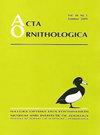波兰西部育雏期灰鹧鸪的栖息地利用和活动习性
IF 1.3
4区 生物学
Q3 ORNITHOLOGY
引用次数: 0
摘要
摘要近几十年来,雏鸡存活率的下降是欧洲灰鹧鸪数量下降的最重要原因之一。因此,在饲养小鸡期间了解这些鸟类的习性是很重要的。1995-2001年,在波兰西部对饲养三周大雏鸡的鹧鸪的栖息地使用、活动和家域大小进行了研究。每天通过无线电跟踪定位21对雏鸡。鹧鸪窝主要使用谷物(占其位置的54.4%),但永久性野生植被(19.6%)是首选。大多数位置(56.8%)发生在距离田地边缘10米的地方。日移动的平均距离为160米(范围为0–890米),在小田地的多样化景观中比在大田地的简化景观中更短。在小鸡出生的前三周,家域面积(100%MCP)平均为12.0公顷(范围为2.9-34.1公顷),两种田地类型之间没有发现显著差异。在发生个体繁殖的地区,随着谷物和野生植被的比例,家庭范围的大小减小。得出的结论是,大规模的麦田比多样化的小麦田为灰鹧鸪的窝创造了更糟糕的生活条件。本文章由计算机程序翻译,如有差异,请以英文原文为准。
Habitat Use and Ranging Behaviour in Grey Partridges Perdix perdix during Chick Rearing Period in Western Poland
Abstract. The decrease in chick survival has been one of the most important reasons for the decline in the abundance of Grey Partridges Perdix perdix in Europe in the recent decades. Therefore, it is important to know the habits of these birds during the period of raising chicks. The habitat use, movements and home range sizes of partridges rearing their chicks up to three weeks old were studied in western Poland in the years 1995–2001. Twenty one pairs with chicks were localized daily by radiotracking. The partridge broods mostly used cereals (54.4% of their locations), but permanent wild vegetation (19.6%) turned out to be preferred. Most locations (56.8%) took place up to 10 m from field edges. The average distance of daily movements was 160 m (range 0–890 m) and was shorter in the diversified landscape of small fields than in the simplified landscape of large fields. The area of home ranges (100% MCP) during the first three weeks of chick's life averaged 12.0 ha (range 2.9–34.1 ha) and no significant differences were found between the two field types. The size of home ranges decreased with the proportion of cereals and wild vegetation in the regions where individual broods occurred. It was concluded that large-scale crop fields create worse living conditions for Grey Partridge broods than more diverse small fields.
求助全文
通过发布文献求助,成功后即可免费获取论文全文。
去求助
来源期刊

Acta Ornithologica
生物-鸟类学
CiteScore
2.10
自引率
0.00%
发文量
14
审稿时长
>12 weeks
期刊介绍:
Publishes scientific papers (original research reports, reviews, short notes, etc.) and announcements from all fields of ornithology. All manuscripts are peer-reviewed.
Established in 1933 as Acta Ornithologica Musei Zoologici Polonici, since 1953 continued under the present title.
Published twice a year by the Natura Optima Dux Foundation under the auspices of the Museum and Institute of Zoology, Polish Academy of Sciences.
 求助内容:
求助内容: 应助结果提醒方式:
应助结果提醒方式:


